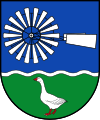Loading AI tools
In heraldry, azure (/ˈæʒər, ˈeɪʒər/ AZH-ər, AY-zhər, UK also /ˈæzjʊər, ˈeɪzjʊər/ AZ-ure, AY-zure)[1][2][3] is the tincture with the colour blue, and belongs to the class of tinctures called "colours". In engraving, it is sometimes depicted as a region of horizontal lines or else is marked with either az. or b. as an abbreviation.
The term azure shares its origin with the Spanish word "azul", which refers to the same color, deriving from Hispanic Arabic lāzaward, the name of the deep blue stone now called lapis lazuli.[4] The word was adopted into Old French by the 12th century, after which the word passed into use in the blazon of coats of arms.
As a heraldic colour, the word azure means "blue", and reflects the name for the colour in the Anglo-Norman dialect spoken by French-speaking Norman nobles following the Norman Conquest of England. A wide range of colour values is used in the depiction of azure in armory and flags, but in common usage it is often referred to simply as "blue".
In addition to the standard blue tincture called azure, there is a lighter blue that is called bleu celeste or "sky blue". Neither azure nor bleu celeste is precisely defined as a particular shade of blue, but azure is consistently depicted in a much darker shade.
Azure plain are the arms of the Swiss family Maienthal. [5]
The different tinctures are traditionally associated with particular heavenly bodies, precious stones, virtues, and flowers, although these associations have been mostly disregarded by serious heraldists.[6] Azure is associated with:
- Arms of Dolní Přím municipality, Hradec Králové District, the Czech Republic.
- Arms of the Dollern municipality
- Arms of the municipality of Holtorfsloh, Seevetal, Lower Saxony.
- Arms of St Cleere family of St Osyth, Essex.
- Arms of Guy Harpigny
- Arms of the Republic of Ireland
 The dictionary definition of azure at Wiktionary
The dictionary definition of azure at Wiktionary
Wikiwand in your browser!
Seamless Wikipedia browsing. On steroids.
Every time you click a link to Wikipedia, Wiktionary or Wikiquote in your browser's search results, it will show the modern Wikiwand interface.
Wikiwand extension is a five stars, simple, with minimum permission required to keep your browsing private, safe and transparent.





